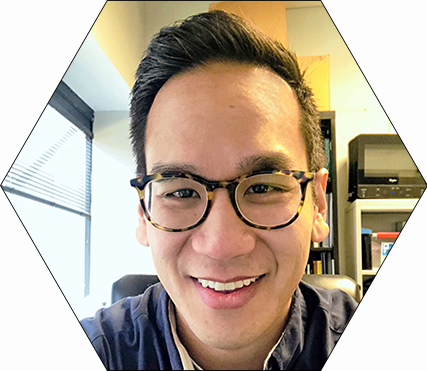Education
- PhD, Purdue University, 2010
- MS, Purdue University, 2006
- BS, Virginia Tech, 2004
Background
Dr. Christopher Saldaña began working at Georgia Tech in 2014. Prior, Dr. Saldaña previously held the Harold and Inge Marcus Career Professorship at the Pennsylvania State University and worked as a research engineer at M4 Sciences Corporation. Dr. Saldaña has also previously held visiting affiliations/positions with the US Air Force Research Laboratory, the Indian Institute of Science (Bangalore, India), Technische Universität Dortmund (Dortmund, Germany), Autodesk, and Sandia National Laboratories. He has received several awards, including an NSF CAREER award, the Robert J. Hocken SME Outstanding Young Manufacturing Engineer award and an R&D100 Technology Award. He serves as an Associate Editor for IISE Transactions (Design and Manufacturing) and serves on the Editorial Boards of Manufacturing Letters, Computer Aided Design and Applications, and the ASTM Journal of Smart and Sustainable Manufacturing.
Research
- Manufacturing and Mechanics of Materials; Additive and hybrid manufacturing; Deformation-based surface processing; Digital and smart manufacturing; Industry 4.0;
Dr. Saldaña's research interests are centered on establishing the processing science needed to realize next generation material systems (alloys, composites, bio-inspired) and manufacturing processes. Toward this objective, Dr. Saldana's research group seeks to develop frameworks for describing relationships between process parameters, thermomechanical variables, evolving material structure and microstructure, and overall process/material performance. A major focus of this effort is on developing process qualification and process design tools for hybrid additive/subtractive manufacturing and digitally-enabled manufacturing. Dr. Saldaña's group maintains and leverages a complement of additive manufacturing platforms (e.g., powder feed directed energy deposition, laser powder bed fusion, hybrid manufacturing, wire-arc deposition), conventional manufacturing equipment, surface/volumetric inspection technologies and material post-processing platforms. These efforts are complemented by multi-scale materials characterization tools (e.g., SEM/TEM, EBSD, XRD, CT, nanoindentation), process measurement methods (e.g., high speed DIC, IR) and analytical/numerical modeling. Dr. Saldaña's research has previously been supported by various government agencies (NSF, DARPA, DMDII, NIST, DOE, ARO, AFRL) and large/small business (Delta Airlines, Volvo, Georgia Pacific, Ford, Applied Process, Third Wave Systems, Manufacturing Labs Inc), among others.
- Georgia Bio Innovation Award (2021)
- Gambrinus Fellowship (2018)
- United States Air Force Summer Faculty Fellowship (2017)
- Robert J. Hocken Outstanding Young Manufacturing Engineer Award, Society of Manufacturing Engineers (2016)
- Research Affiliate of the International Academy for Production Engineering or Centre International pour la Recherche en Productique, CIRP (2016)
- National Science Foundation CAREER Award (2013)
- Finalist, Dow Chemical Sustainability Innovation Challenge (2013)
- Best Oral Presentation, 6th Ultrafine-Grained Materials Symposium, TMS (2010)
- R&D Magazine's R&D100 award (2010)
- Eastman-Kodak Doctoral Fellowship (2009)
- 1st Place, Burton D. Morgan Entrepreneurial Competition (2007)
- National Science Foundation Graduate Research Fellowship (2004)
Patents
-
S. Chandrasekar, K. P. Trumble, W. Moscoso, M. Efe, D. Sagapuram, C. J. Saldana, J. B. Mann, W. D. Compton, “Large strain extrusion machining processes and bulk forms produced therefrom,” US9687895 (patent grant number), awarded/published 27 June 2017.
-
J. B. Mann, S. Chandrasekar, C. Saldana, Y. Guo, W. D. Compton, “Method of producing textured surfaces,” US9527134 (patent grant number), awarded/published 27 December 2016.
-
J. B. Mann, C. Saldana, W. Moscoso, “Control systems and methods for machining operations,” US 8694133 B2 (grant), publication 8 April 2014.
Representative Publications
- H. Qiao, T. G. Murthy, C. Saldana, "Structure and deformation of gradient metal foams produced by machining," ASME Journal of Manufacturing Science and Engineering, 2019, Vol. 141 (7), 071009.
- M. Praniewicz, T. R. Kurfess, C. Saldana, "An adaptive geometry transformation and repair method for hybrid manufacturing," ASME Journal of Manufacturing Science and Engineering, 2019, Vol. 141 (1), 011006.
- Z. Wang, T. G. Murthy, C. Saldana, "Deformation field in sequential circular indentation of a strain hardening material," Philosophical Magazine, 2019, Vol. 99, pp. 1259-1276.
- S. Basu, Z. Wang, R. Liu, C. Saldana, “Enhanced subsurface grain refinement during transient shear-based surface generation,” Acta Materialia, 2016, Vol. 116, pp. 114-123.
- S. Yadav, C. Saldana, T. G. Murthy, “Porosity and geometry control ductile to brittle deformation in indentation of porous solids,” International Journal of Solids and Structures, 2016, Vol. 88-89, pp. 11-16.
- D. Sagapuram, Z. Wang, C. Saldana, "Thermal stability of nano-twinned and nanocrystalline microstructures produced by cryogenic shear deformation," Philosophical Magazine, 2014, accepted.
- F. Du, S. Yadav, C. Moreno, T. G. Murthy, C. Saldana, “Incipient straining in severe plastic deformation methods,” Journal of Materials Research, 2014, Vol. 29, pp. 718-728.
- T. G. Murthy, C. Saldana, M. Hudspeth, R. M’Saoubi, “Deformation heterogeneity in punch indentation,” Proceedings of the Royal Society of London A, 2014, Vol. 470, 20130807. Article featured as cover image of June 2014 issue of PRSA.
- C. Saldana, A. H. King, S. Chandrasekar, “Thermal stability of deformation microstructures in pure copper,” Acta Materialia, 2012, Vol. 60, pp. 4107-4116.
- C. Saldana, A. H. King, E. A. Stach, S. Chandrasekar, “Vacancies, twins and the thermal stability of ultrafine-grained copper,” Applied Physics Letters, 2011, Vol. 99, 231911.
- C. Saldana, P. Yang, J. B. Mann, W. Moscoso, D. D. Gill, S. Chandrasekar, K. P. Trumble, “Micro-scale components from high-strength nanostructured alloys,” Materials Science and Engineering: A, 2009, Vol. 503, pp. 172–175.

